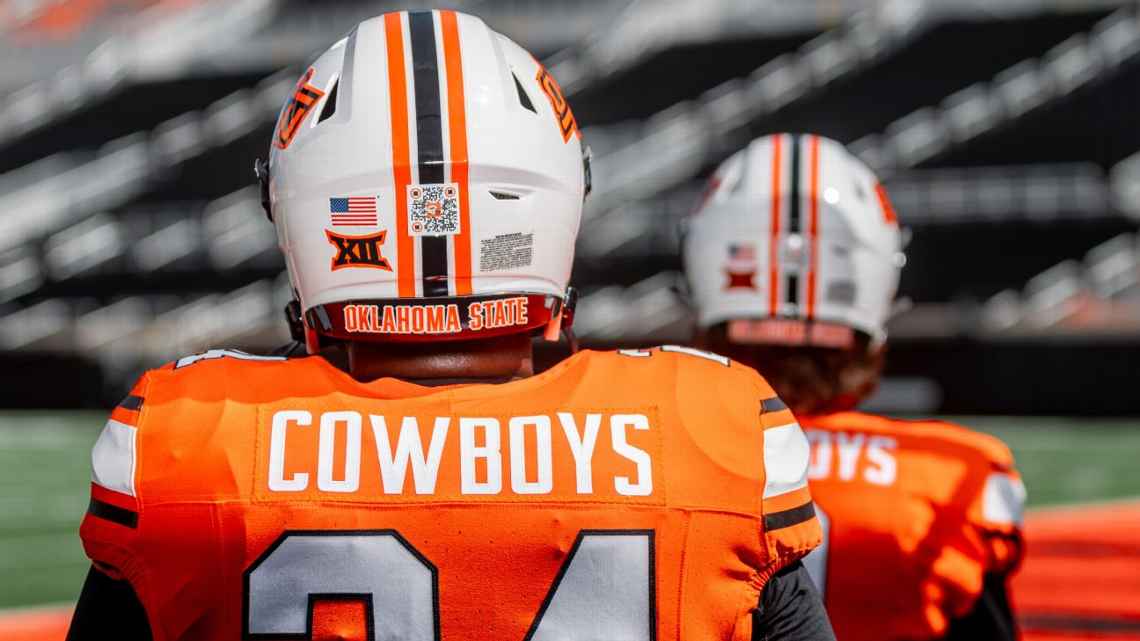Mike Gundy’s Oklahoma State Cowboys Take an Innovative Approach to NIL with QR Codes on Helmets

As the 2024 college football season rapidly approaches, Oklahoma State head coach Mike Gundy is keen on ensuring his players shift their focus from the increasingly complex “business side” of Name, Image, and Likeness (NIL) deals to the game on the field. With the season opener just days away, Gundy is introducing a groundbreaking initiative that could redefine how college athletes benefit from NIL during the season.
Oklahoma State University announced an innovative strategy that could set a precedent in college football: the Cowboys will feature QR codes on their helmets, linking directly to a donation page for the team’s NIL fund. This is believed to be the first time such a tactic has been employed in college football, making it a revolutionary step forward in the NIL landscape.
The QR codes, which will be 1.5 square inches in size, will be positioned on the back of each player’s helmet. While these codes may not be visible to fans in the stands, they are designed to be easily captured by viewers watching the game on television. This approach allows fans from around the world to contribute to the Cowboys’ NIL fund, enhancing the players’ opportunities to earn NIL money throughout the season.
“This is a revolutionary step forward to help keep Oklahoma State football ahead of the game,” Gundy said. “It gives a chance for everyday fans across the world to have a real impact when it comes to supporting the NIL efforts for Cowboy football. I’m thrilled about this opportunity for our players.”
The introduction of QR codes on helmets comes at a time when the NIL era has significantly altered the college football landscape. The ability for college athletes to profit from their name, image, and likeness has introduced new dynamics, including the involvement of agents, negotiations, and the potential for distractions off the field.
Last week, Gundy expressed his concerns about the ongoing negotiations and haggling that have become a part of the NIL environment. He emphasized the importance of focusing on football, particularly as the season draws near. “We have to have those conversations with [the players]. ‘Tell your agent to quit calling us and asking for more money.’ It’s non-negotiable now. It’ll start again in December,” Gundy explained. “So now we’re able to direct ourselves just in football, and that part is fun.”
Gundy’s sentiments reflect the broader challenges coaches face in the NIL era. Balancing the business aspects of college football with maintaining a team’s focus on winning games has become a delicate act. By introducing the QR codes, Gundy and Oklahoma State are not only addressing the financial aspects of NIL but are also providing a streamlined solution that allows players to concentrate on the game while still benefiting from NIL opportunities.
The Oklahoma State Cowboys are set to kick off their season on August 31 against the defending FCS national champions, South Dakota State. The Cowboys enter the season ranked No. 18 in ESPN’s preseason rankings, with star running back Ollie Gordon II leading the charge. Gordon, who led the nation with 1,732 rushing yards last season, is expected to be a key player for the Cowboys as they navigate the upcoming season.
“The good news is, the next five months we can just play football,” Gundy said. “There’s no negotiating now. The portal’s over. All the negotiation’s history. Now we’re playing football.”
For Oklahoma State, the focus is now on the field, but with the innovative QR code initiative, the Cowboys have also found a way to keep the NIL momentum going. This approach not only supports the players financially but also engages the fan base in a new and meaningful way. As the season progresses, it will be interesting to see how this pioneering move impacts both the team’s performance and the broader NIL landscape in college football.
In a world where college athletes are increasingly aware of their value, Oklahoma State’s approach could serve as a model for other programs looking to balance on-field performance with off-field business opportunities. Gundy’s strategy represents a forward-thinking approach to the evolving world of college sports, where innovation and tradition must coexist for the benefit of the players and the program.